Mercedosaurus Rex at Indianapolic Park
Part 4: Equivalency formulas - waiting for things to go wrong
Author
- Henri Greuter
Date
- September 22, 2009
Related articles
- March-Alfa Romeo 90CA - Fiasco Italo-Brittanico, by Henri Greuter
- March-Porsche 90P - The last oddball at the Indianapolis Motor Speedway, by Henri Greuter
- Penske-Mercedes PC23-500I - Mercedosaurus Rex at Indianapolic Park, by Henri Greuter
- Introduction
- Part 1: Penske Racing at Indianapolis - new standards
- Part 2: Ilmor Engineering at Indianapolis
- Part 3: Mercedes, Benz and Mercedes-Benz at Indianapolis up until 1993
- Part 5: Stock blocks - keeping them rolling and promoting 'Born in the USA' technology
- Part 6: Indianapolis 1991 - Chevy And Rich Team owners
- Part 7: The Speedway narrowed, its speeds lowered
- Part 8: The forerunner
- Part 9: Pre-May '94 plans
- Part 10: Penske PC23 - a home for the engine
- Part 11: The 1994 Indycar season until mid-April
- Part 12: The unfair advantage and when others have it
- Part 13: Practice during the 1994 'Month of May'
- Part 14: Other bespoke-design 209s
- Part 15: From the last weekend of May '94 to the end of the season
- Part 16: Could the Mercedes Benz 500I have been stopped in time?
- Part 17: Creating an extinct species without it being forbidden, initially at least
- Part 18: The 1995 '500' - Did the Mercedosaurus bite its masters after all?
- Part 19: A possible twist of fate for Rahal-Hogan and Penske as a legacy of the 500I
- Part 20: Re-evaluation of our verdict
- Part 21: PC23's further active career after 1994
- Part 22: USACís points of views and some answers
- Part 23: The loose ends that didnít fit in anywhere else and the epilogue
- Part 24: "Plan your work; work your plan" - Chuck Sprague on the PC23
- Appendix 1: Specifications
- Appendix 2: Car and driver appearances and performances during the Month of May 1994
- Appendix 3: Chassis, entry, practice and race numbers in 1994
- Appendix 4: PC23's 1994 results sans Mercedes Benz 500I
- Appendix 5: PC23's 1995-'96 results sans Mercedes Benz 500I
- Appendix 6: A reflection on the PC23 chassis used by Team Penske in 1994
- Appendix 7: A review of Beast by Jade Gurss
Who?Parnelli Jones What?STP-Paxton-Pratt & Whitney 'Silent Sam' Where?Indianapolis When?1967 Indianapolis 500 |
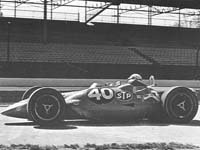 |
Why?
A number of factors were responsible for the fact that the car we shall refer to as the Penske-Mercedes came into existence. We will have a look on those factors here.
The 500 miles of Indianapolis has traditionally been an event in which only one type of engine was commonly used. Rules permitted alternative engines but ever since WW2 the unblown Meyer-Drake-Offenhauser was the most commonly used engine up until 1965. Some years the entire field of 33 cars was Offy-powered.
Alternative engines were permitted, blown ones with two-third of the capacity of unblown engines being the major alternative option. None of those engines was a success. The Novi V8 won a few poles, missed out on pole but was still fastest qualifier on several occasions, but a single third place and two fourths were its best results.
As for truly alternative types of engines, the Cummins company shocked the Indy scene when they fielded a turbocharged diesel-engined car that won the pole in 1952. The eligible engines that year were:
- Non-stock supercharged: 183.060 CI (3000cc) or less
- Non-stock non-supercharged: 274.59 CI (4500cc) or less
- Diesel supercharged, four-stroke cycle: 402.68 CI (6600cc) or less
- Diesel supercharged, two-stroke cycle: 274.59 CI (4500cc) or less
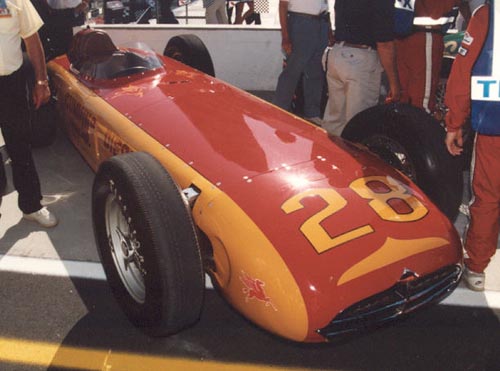
Seen for a demo run in 1994, the revolutionary 1952 Cummins diesel. A revolution with its laydown engine, asymmetric driveline and turbocharger. All elements that were to stay and/or return at Indianapolis after 1952. The diesel engine however was not. Given its truck heritage, the engine of this car could be considered having a stock heritage too. (photo HG)
One year later the restrictions on diesels were tightened dramatically and although not forbidden they no longer formed a serious option. I could not find evidence of these restrictions already being applied in 1953 but the published entry list of 1954 stated that diesels were restricted to 335.57 CI (5500cc). But this same list mentions how USAC introduced a new potential source of controversy since gas turbines appeared on the list of eligible engines but without any limitations - although it was announced that these were to be installed after the 1955 raceÖ
Stock blocks were allowed as well in the early 50s and permitted to be a full litre larger in capacity. That extra capacity was instantly disallowed when such an engine (a Chrysler) performed more than creditable in test runs late 1952. The conservative team owners made it very clear to USAC that they didnít want their Offy engines being made obsolete in an instant and being forced to spend even more money on getting suitable replacements. Chrysler tried to get the job done without the extra litre but the attempt failed. Studebaker built a DOHC cylinder head for their smallblock V8, increased to 4.5 litres, but the engine broke down on the first attempt to start it up while installed in a car. This meant that team owner JC Agajanian had his team concentrate on the Offy-powered car he had entered as well. End of story for that attempt to promote stock blocks.
Turbine engines were another category of alternatives that were allowed, but the 1962 John Zink Turbine didnít set the world alight, nor did the Demler car in 1966. The Granatelli brothers did a far better job in applying turbine power (and torque!) to a racing car and two years in a row they nearly won the Memorial Day Classic with their Silent Furies. A turbulent era in USAC history was finished once and for all when USAC set rules for turbines technically still allowing then but effectively outlawing them for good.
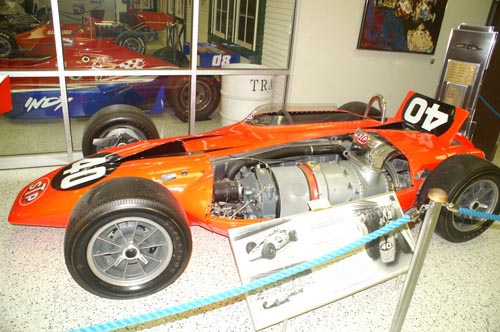
Never before had an alternative engine been so close to winning at Indianapolis as the Paxton-Pratt & Whitney in 1967. It went on to win that year's 'Indy 490'Ö (photo HG)
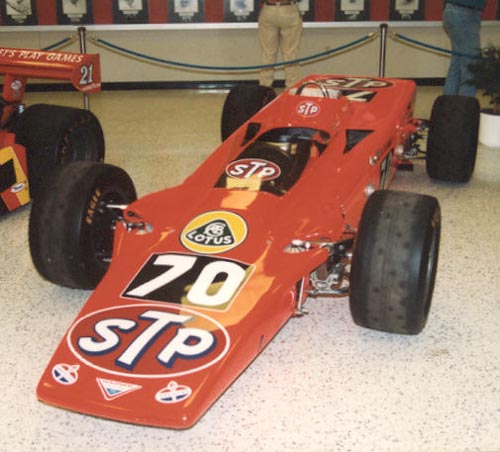
The turbine-powered Lotus cars were strangled in performance. It was a sheer miracle that one of them came so close to nonetheless winning the 1968 raceÖ (photo HG)
To give you an idea of what USAC allowed in 1967 and how they were forced to change the rules just about every remaining year of the sixties, here is an overview. In 1967 the rules read as follows. Eligibility was restricted to:
1: Supercharged four-cycle overhead cam engines: 170.856 CI (2800cc) or less
2: Non-supercharged four-cycle overhead cam engines: 256.284 CI (4200cc) or less
3: American stock production block design, single non-overhead camshaft, removable head, non-supercharged engines 305.2 CI (5000cc) or less
4: Two-cycle engine, other than diesel engines, supercharged or not, 170.856 CI (2800 cc) or less
5: Diesel engines, supercharged, two or four cycle, 203.4 CI (3333 cc) or less
6: Diesel engines, non supercharged, two or four cycle, 305.2 CI (5000 cc) or less
7: Gas turbine engines incorporating axial flow design compressors, total inlet annulus area of 23 square inches or less, measured at the entrance to the first moving stage of the compressor section
8: Gas turbine engines incorporating centrifugal design compressors, total inlet annulus area of 28.5 square inches or less
9: Rotating combustion engines, not supercharged, 256.284 CI (4200 cc) or less based on maximum volume minus minimum volume of one rotating chamber
10: Energy or fuel cells, hydraulic accumulators and steam engines complying with current USAC specifications for each type propulsion.
The changes for 1968 (courtesy of 'Silent Sam') were:
7: Gas turbine engines incorporating axial flow design compressors, total inlet annulus area of 15.999 square inches or less, measured at the entrance to the first moving stage of the compressor section
8: and 10: were no longer mentioned as eligible.
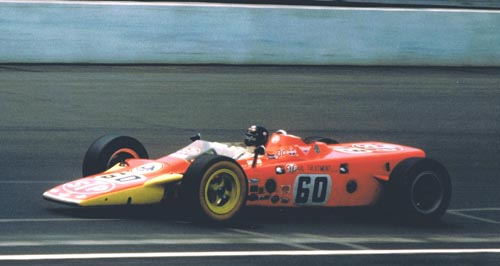
The second consecutive heartbreak for a turbine engine in the late sixties. In 1968, Joe Leonard almost made it home in the STP Lotus 56 turbine car. If it hadn't been for a fuel pump shaft breaking on lap 192...
(copyright First Turn Productions LLC, used with permission)
The changes for 1969 were:
1: Supercharged four cycle overhead cam engines: 161.703 CI (2650 cc) or less
3: American stock production block design, single non-overhead camshaft, removable head, non supercharged engines 320.355 CI (5250 cc) or less.
7: Gas turbine engines incorporating axial flow design compressors, total inlet annulus area of 11.999 square inches or less, measured at the entrance to the first moving stage of the compressor section; and all cars powered by gas turbine engines must have facilities as stipulated by USAC to prevent escapement of debris resulting from turbine failure.
In the late 60s, when pure-bred turbocharged racing engines became the thing to have, USAC began to promote the normally aspirated stock block once again. Dan Gurney was successful at Indy with a Ford in the late 60s, finishing second in both 1968 and í69, but the stock block did not win.
To give you an indication of what was permitted, the following engines were allowed in 1977:
- four-cycle supercharged overhead-camshaft engines of 161.7 CI or 2650 cc
- four-cycle non-supercharged overhead-camshaft engines of 274.59 CI or 4500 cc
- Stock production block design, supercharged, single non-overhead cam, removable-head engines of 209.3 CI or 3430 cc
- Stock production block design, non-supercharged, single non-overhead cam, removable-head engines of 355,136 CI or 5820 cc
- Special rocker arm, non-supercharged, single non-overhead camshaft, removable-head engines of 320.355 CI or 5250 cc.
It became a bit more complicated shortly after when different boost levels were introduced for the supercharged four-cycle overhead-camshaft engines, depending on their cylinder count. The Offy four-cylinders were permitted a higher boost compared to the V8s to keep them competitive. Initially, the Offies had a little over 1.0 bar of boost, sixes had 0.8 and the V8s got 0.6 bar. When Porsche announced they would enter the 1980 race with a reworked version of their flat-6, the rules were changed all of a sudden, with six-cylinders deemed comparable to V8s. After that trick, no-one else ever tried a DOHC six, and with the Offy effectively out of business from 1980 on, the problem of different boost levels within the same engine category was gone.
From 1980 to 1982 the normally aspirated Chevy V8 caused another brief revival of unblown stockblocks, but although they were popular with a number of racing fans they never succeeded at Indy. Turbocharged stockblocks too gradually made their presence known during the early 80s but none of these made much impact up until 1985.
The most serious option remained the mildly turbocharged quad-cam 2.65 liter V8, or the Cosworth DFX to be precise.
From 1986 on more of V8 engines of this kind became available, such as the Ilmor/Chevrolet and the Honda/Judd. These were joined by the Porsche team using its own V8 from 1988 on, and Alfa Romeo with their V8 from mid-1989 on, making its debut at IMS in 1990.
But USAC still had a desire to see a variety of engines competing at Indianapolis. For this, they favoured a variety cheaper compared to pure-bred racing engines, thus allowing more competitors to try to qualify for the race. The more while USAC wanted every competitor to be competitive, be it a big powerful CART team or a 'Once a year only' effort. With the raise to power by the Ilmor Chevy from 1988 on the chance to succeed in the race was reduced to the 'elite' chosen by Ilmor. That was also why USAC saw it as their duty to provide the other competitors with suitable options to take on the Ilmor brigade. And if that meant favouring an entirely different kind of internal combustion engine, then so be it.
In this section, I gave most attention to engines other than the four-stroke Otto-principle combustion engines tried out at Indianapolis. The stock-block engines challenging the purebred racing engines haven't been given that much attention, yet this was the group of alternatives on purebred racing engines that were tried most often, by the largest number of hopefuls and with the most variety. Their success, however, was limited to a few examples. An overview of stock-block engines that were tried using these equivalency rules will be presented elsewhere.
